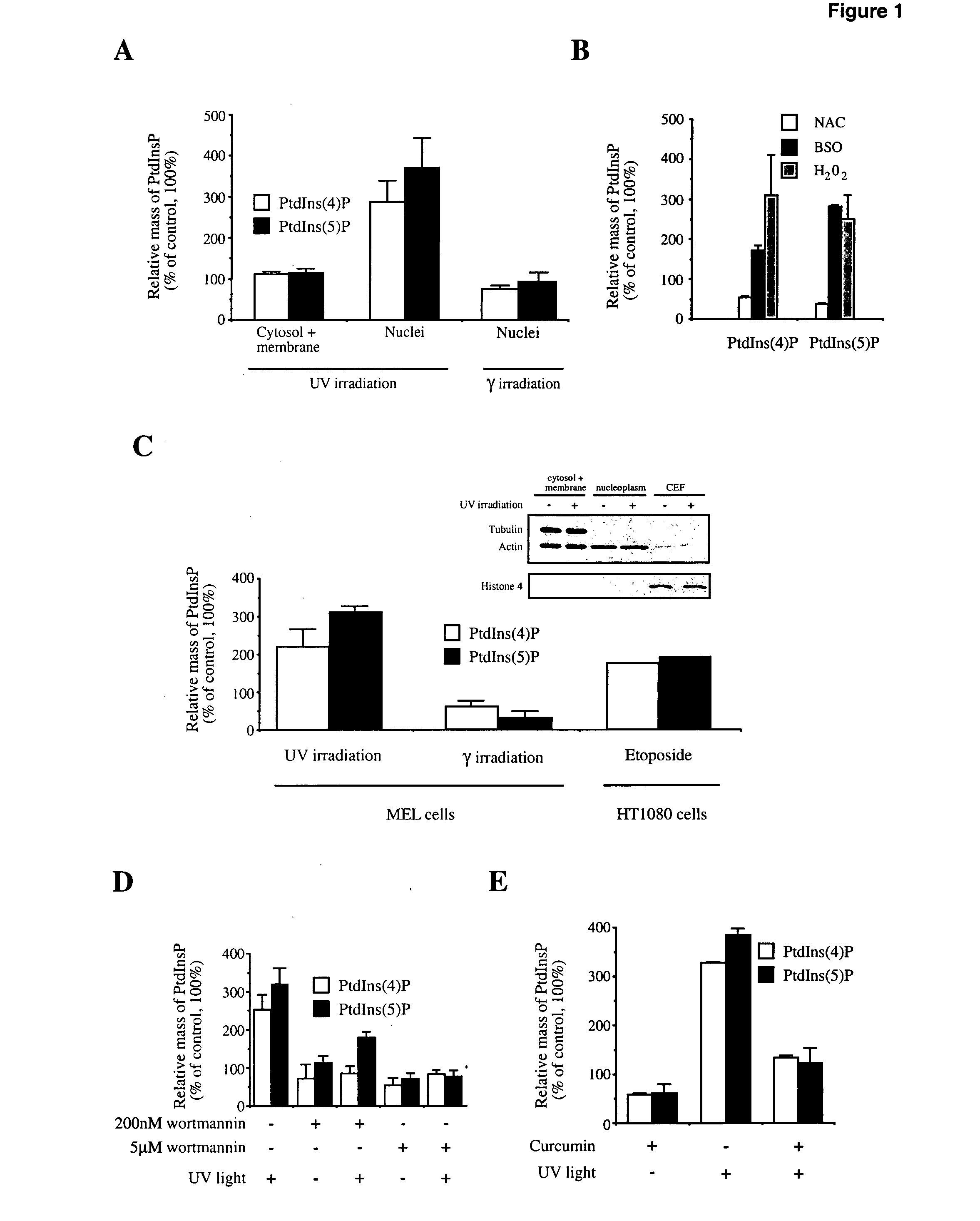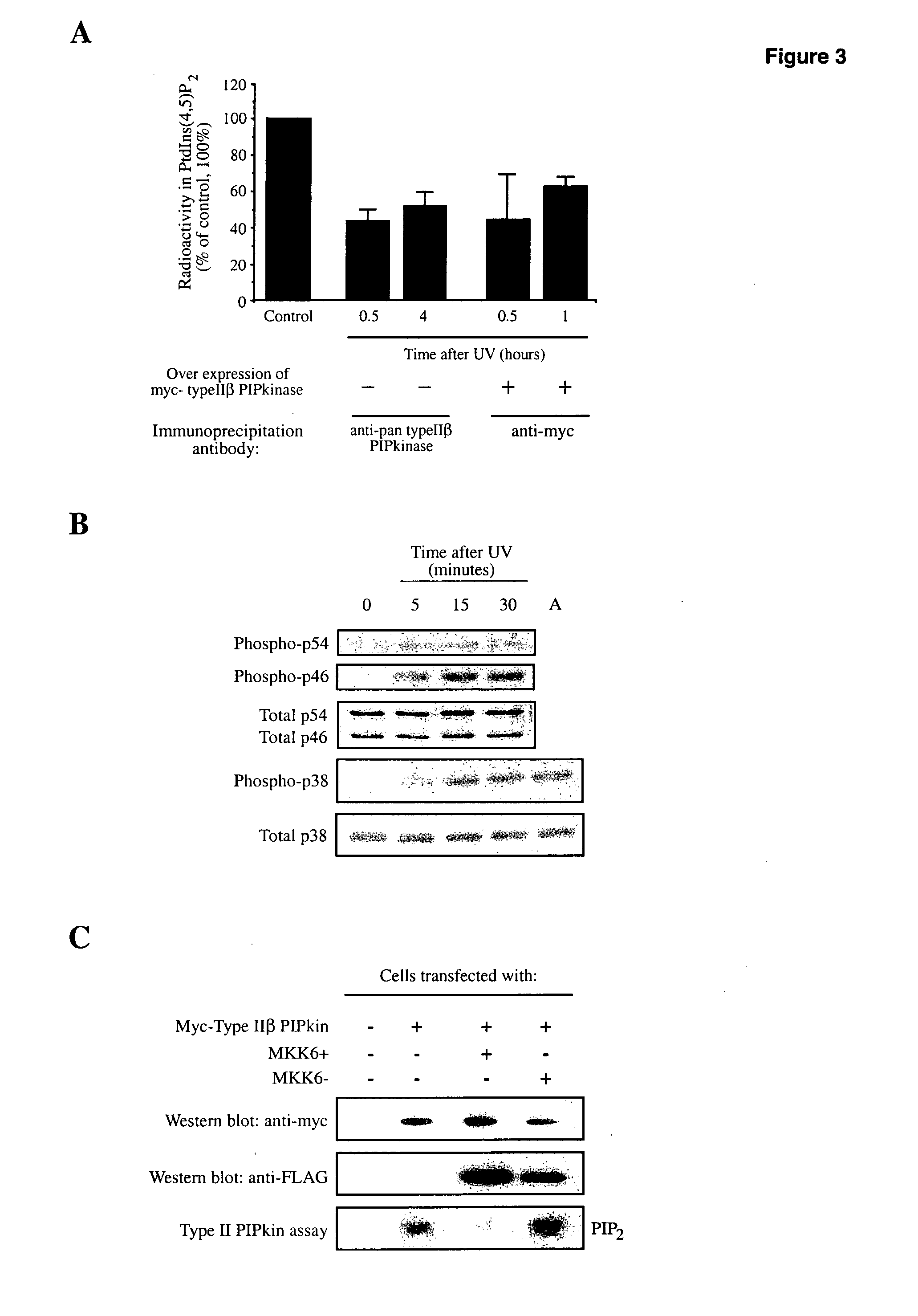Methods of treatment
a treatment method and technology of ptdins, applied in the field of treatment methods, can solve the problems of not providing further information on the mechanism of ptdins5p or ptdins4p, and achieve the effect of reducing the level of ptdins and preventing apoptosis
- Summary
- Abstract
- Description
- Claims
- Application Information
AI Technical Summary
Benefits of technology
Problems solved by technology
Method used
Image
Examples
example 1
[0380]Various forms of irradiation, chemicals such as etoposide and cisplatin, highly reactive free radicals and peroxides, hypoxia and the deprivation of essential nutrients lead to intracellular damage (proteins, lipids and DNA), which can initiate pathways aimed at repairing the damage. Cellular phosphoinositide levels have previously been shown to change as a consequence of osmotic, oxidative and UV damage in mammalian cells and to drought and salt stress in plants. However, no studies have determined a role for nuclear phosphoinositides or defined downstream protein targets mediating phosphoinositide-stress activated pathways. To study changes in nuclear phosphoinositides in response to cellular stress, we used Murine erythroleukaemia (MEL) cells as a model system because preparations of nuclei from these cells have been proven to be of high purity. To visualise changes in phosphoinositides, various independent methods were used. The mass level of both PtdIns4P and PtdIns5P wer...
example 2
[0385]The PHD finger of p33ING2 / INGL binds to phosphomonoinositdes (Gozani et al). ING2 has been shown to be nuclear, suggested to regulate gene transcription in response to stress and therefore represents a good candidate as an in vivo sensor of nuclear PtdInsPs. CEF isolated from MEL cells before and after treatment with various cellular stresses that do (UV and oxidative stress) or do not (gamma irradiation) increase the levels of nuclear PtdInsPs were probed for the presence of endogenous ING2. UV irradiation led to an increased level of endogenous ING2 associated with the CEF (FIG. 4a), whilst gamma irradiation did not (FIG. 4a). Although some UV-induced responses are dependent on an increase in cellular reactive oxygen species, pre-treatment of cells with NAC did not block UV-mediated translocation of ING2 (FIG. 4b). Treatment of differentiated cells with H2O2, which causes an increase in nuclear PtdIns4P and PtdIns5P (FIG. 1b), also stimulated ING2 translocation to the CEF (F...
example 3
Regulation of Cellular PtdIns(4,5)P2 Levels
[0389]Changes in intracellular PtdIns(4,5)P2 levels following stimulation with neurokinin A were visualised in real time using a fusion protein of GFP and the PH domain of PLCdelta1 as a probe. GFP PLC delta 1 is a highly specific in vivo probe for PIP2 in cells.
[0390]HeLa cells were transiently transfected with an expression plasmid encoding a fusion protein of GFP and the PH domain of PLCdelta1. PtdIns(4,5)P2 levels were monitored before, during and after stimulation with neurokinin A. Results are shown in FIG. 9.
[0391]This experiment shows that growth factors such as neurokinin A stimulate PtdIns(4,5) P2 depletion, which can be visualised in real time with our PtdIns(4,5)P2 probe. Cells quickly recover their PtdIns(4,5) P2 levels after growth factor stimulation prompting the return of the probe back to the plasma membrane. Healthy cells tightly manage their PtdIns(4,5)P2 levels.
PUM
| Property | Measurement | Unit |
|---|---|---|
| diameter | aaaaa | aaaaa |
| concentration | aaaaa | aaaaa |
| pore-size | aaaaa | aaaaa |
Abstract
Description
Claims
Application Information
 Login to View More
Login to View More - R&D
- Intellectual Property
- Life Sciences
- Materials
- Tech Scout
- Unparalleled Data Quality
- Higher Quality Content
- 60% Fewer Hallucinations
Browse by: Latest US Patents, China's latest patents, Technical Efficacy Thesaurus, Application Domain, Technology Topic, Popular Technical Reports.
© 2025 PatSnap. All rights reserved.Legal|Privacy policy|Modern Slavery Act Transparency Statement|Sitemap|About US| Contact US: help@patsnap.com



